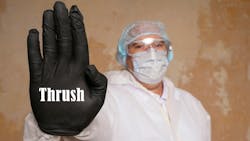Thrush be gone: How dental hygienists can win the battle against this fungal foe
Listen to the article on our podcast!
Oral candidiasis, better known as oral thrush, is a fungal infection that thrives when the delicate balance of microorganisms in the mouth is disrupted. While Candida albicans is a normal resident of the oral microbiome, it can quickly overgrow under the right conditions, leading to uncomfortable symptoms. Dental professionals frequently see this in older adults, denture wearers, immunocompromised patients, and those on certain medications.
Since many of these patients are on multiple prescriptions, it’s important to assess their medication history for risk factors and potential drug interactions, for example, antibiotics wiping out beneficial flora or inhaled steroids altering the oral environment. Tools such as the Digital Drug Handbook make it easy to check for interactions and adjust treatment plans accordingly to ensure safe and effective care.
Who’s at risk for thrush?
Oral thrush is more than just a nuisance; it often signals an underlying issue. Some of the most common risk factors include:
- Diabetes: Uncontrolled blood sugar fuels Candida growth, making these patients especially susceptible.
- Xerostomia (dry mouth): Whether due to medications, Sjögren’s syndrome, or radiation therapy, reduced saliva flow creates the perfect environment for fungal overgrowth.
- Corticosteroid inhalers: Patients using inhaled steroids (for asthma or COPD) are at high risk, especially if they don’t rinse their mouths afterward.
- Denture wearers: Poorly fitting or unclean dentures can harbor Candida, leading to denture stomatitis.
- Broad-spectrum antibiotics: Wiping out beneficial bacteria gives Candida the opportunity to take over.
- Immunosuppression: (HIV/AIDS, cancer treatments): When the body’s defenses are down, oral candidiasis is more likely to appear.
Recognizing oral candidiasis in your patients
While the classic presentation is white, curd-like plaques on the tongue, inner cheeks, or palate, oral candidiasis doesn’t always follow the textbook definition. Some patients experience:
- Red, inflamed areas (especially under dentures) without obvious white patches
- Cracked, sore corners of the mouth (angular cheilitis)
- A burning sensation or altered taste
- Difficulty swallowing, especially in severe cases
Lesions typically wipe away easily, leaving behind an erythematous or bleeding surface. If you’re ever unsure, a KOH smear or fungal culture can confirm the diagnosis.
Treatment: What works best?
The goal of treatment is twofold: eliminate the fungal overgrowth and address the underlying cause. Here’s what to consider:
First-line therapy: Topical antifungals
- Nystatin (suspension, swish and swallow/spit, QID): A go-to option but requires patient compliance.
- Clotrimazole troches (10 mg, dissolve in mouth five times/day): Great for patients who can manage frequent dosing.
- Miconazole mucoadhesive tablets (buccal, once daily): A convenient option with high efficacy.
For patients with chronic chapped lips who are not responding to lip balm or Aquafor, suggest over-the-counter miconazole or clotrimazole cream. The cream may indicate usage for a yeast infection in another part of the body.
When to consider systemic antifungals
For persistent or severe cases, fluconazole (100-200 mg/day for 7–14 days) is a reliable choice. Refractory cases may require itraconazole or posaconazole.
Adjunctive and preventive strategies
- Denture hygiene: Emphasize nightly removal and cleaning with antifungal solutions.
- Oral hygiene reinforcement: Regular brushing (including the tongue) and antiseptic rinses can help.
- Encourage saliva production: Patients with xerostomia may benefit from saliva substitutes or sialogogues such as pilocarpine.
- Dietary modifications: Reducing sugar intake and incorporating probiotics may help maintain a healthy oral microbiome.
Oral candidiasis is common, but it should not be overlooked. Identifying risk factors and catching it early can prevent discomfort and complications for your patients. Assessing their medications is a key part of this process, and resources such as the MedAssent DDS Digital Drug Handbook can help ensure antifungal prescriptions are safe and effective alongside their existing treatments.
By staying proactive, we can help patients manage and prevent these infections before they escalate.
About the Author

Lisa Chan, DDS
Lisa Chan, DDS, is a dentist with over 35 years of experience spanning roles in hospital dentistry, private practice, and as a consultant to the California State Dental Board. A graduate of the University of Southern California School of Dentistry, she is passionate about community dentistry, health-care equity, and bridging medicine and dentistry to improve patient safety. As cofounder of MedAssent DDS, she is helping redefine clinical decision-making for dental professionals.

Aubrey Glassberg, BS
Aubrey Glassberg, BS, project manager at MedAssent DDS, is key in content creation and editorial review. With a bachelor’s degree in World Arts and Culture from UCLA, she excels in crafting articles that resonate with the dental community. Her attention to detail and creativity make each piece informative and engaging. Beyond editorial duties, Aubrey manages various projects, including overseeing the medication database at MedAssent DDS.


